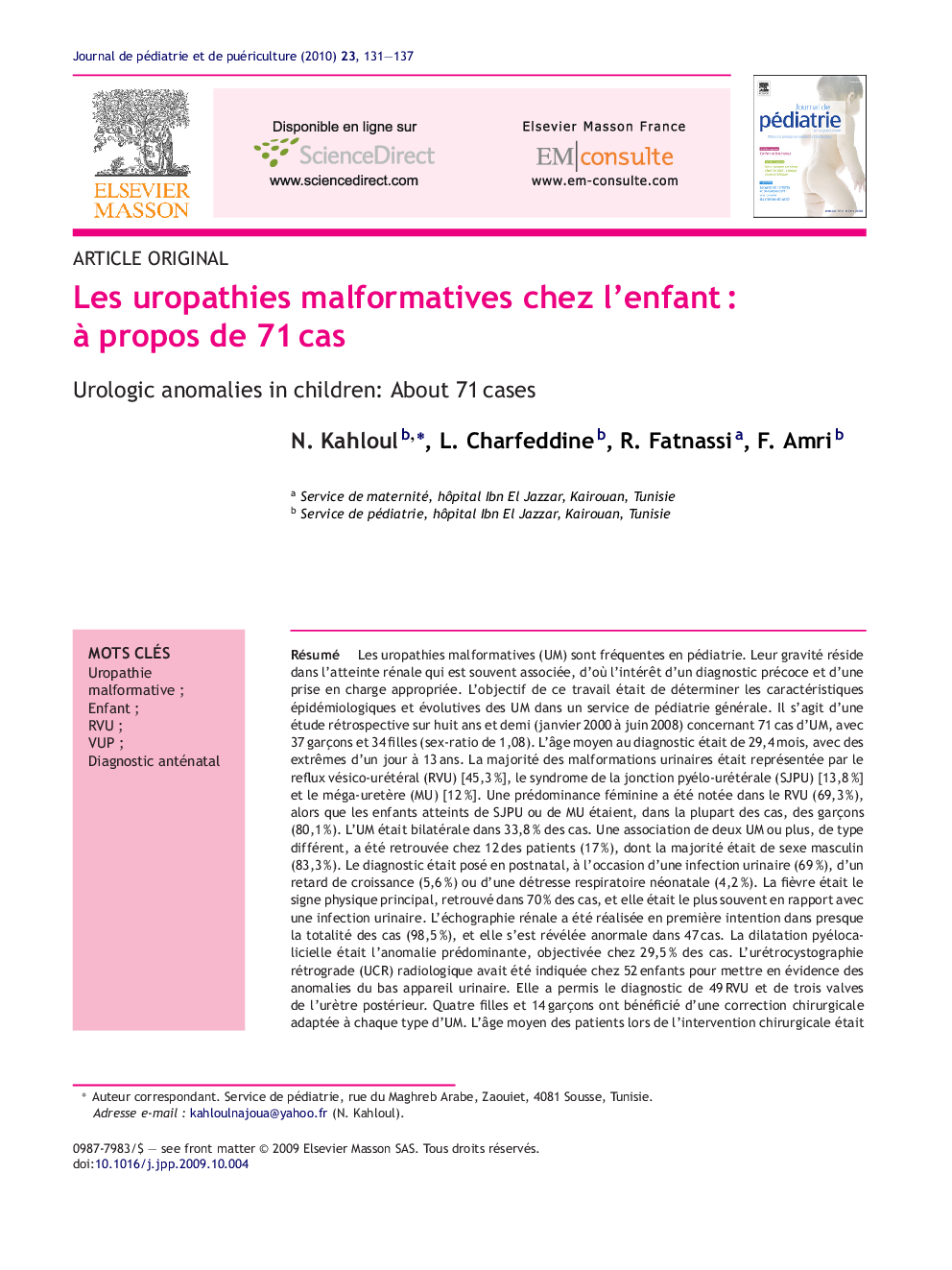| Article ID | Journal | Published Year | Pages | File Type |
|---|---|---|---|---|
| 4170141 | Journal de Pédiatrie et de Puériculture | 2010 | 7 Pages |
RésuméLes uropathies malformatives (UM) sont fréquentes en pédiatrie. Leur gravité réside dans l’atteinte rénale qui est souvent associée, d’où l’intérêt d’un diagnostic précoce et d’une prise en charge appropriée. L’objectif de ce travail était de déterminer les caractéristiques épidémiologiques et évolutives des UM dans un service de pédiatrie générale. Il s’agit d’une étude rétrospective sur huit ans et demi (janvier 2000 à juin 2008) concernant 71 cas d’UM, avec 37 garçons et 34 filles (sex-ratio de 1,08). L’âge moyen au diagnostic était de 29,4 mois, avec des extrêmes d’un jour à 13 ans. La majorité des malformations urinaires était représentée par le reflux vésico-urétéral (RVU) [45,3 %], le syndrome de la jonction pyélo-urétérale (SJPU) [13,8 %] et le méga-uretère (MU) [12 %]. Une prédominance féminine a été notée dans le RVU (69,3 %), alors que les enfants atteints de SJPU ou de MU étaient, dans la plupart des cas, des garçons (80,1 %). L’UM était bilatérale dans 33,8 % des cas. Une association de deux UM ou plus, de type différent, a été retrouvée chez 12 des patients (17 %), dont la majorité était de sexe masculin (83,3 %). Le diagnostic était posé en postnatal, à l’occasion d’une infection urinaire (69 %), d’un retard de croissance (5,6 %) ou d’une détresse respiratoire néonatale (4,2 %). La fièvre était le signe physique principal, retrouvé dans 70 % des cas, et elle était le plus souvent en rapport avec une infection urinaire. L’échographie rénale a été réalisée en première intention dans presque la totalité des cas (98,5 %), et elle s’est révélée anormale dans 47 cas. La dilatation pyélocalicielle était l’anomalie prédominante, objectivée chez 29,5 % des cas. L’urétrocystographie rétrograde (UCR) radiologique avait été indiquée chez 52 enfants pour mettre en évidence des anomalies du bas appareil urinaire. Elle a permis le diagnostic de 49 RVU et de trois valves de l’urètre postérieur. Quatre filles et 14 garçons ont bénéficié d’une correction chirurgicale adaptée à chaque type d’UM. L’âge moyen des patients lors de l’intervention chirurgicale était de 38,4 mois. Une résolution spontanée de l’UM a été observée chez 21 patients ; il s’agissait de 20 RVU, de sept SJPU et de quatre MU. Deux des patients ont progressivement évolué vers l’IR chronique. Le diagnostic anténatal (DAN) devrait être actuellement la principale circonstance de découverte de ces anomalies, dont la majorité est constituée de formes peu ou non compliquées qui présentent un pronostic et une évolution favorables, spontanément ou après correction chirurgicale.
SummaryThe malformative uropathy (MU) is frequent in paediatrics. Its gravity resides in the renal failure, that is often associated, hence the interest of an early diagnosis and a suitable management. The authors of this study wanted to determine the epidemiological and evolutionary features of the MU in a service of general paediatrics. It is a retrospective survey on eight and a half years (from January 2000 to June 2008), concerning 71 cases of MU, with 37 boys and 34 girls (sex ratio of 1.08). The mean age at diagnosis was 29.4 months, with extremes of one day to 13 years. The majority of urinary malformation was represented by the vesical urethral reflux (RVU) [45.3 %], the syndrome of the pyelo-ureteral junction (SJPU) [13.8 %] and the mega-ureter (MU) [12 %]. A feminine predominance was noticed in the RVU (63.3 %), but the children with SJPU or MU were mostly boys (80.1 %). The MU was bilateral in 33.8 % of the cases. An association of two MU or more different type was found for 12 of the patients (16.9 %), whose majority was of masculine sex (83.3 %). The diagnosis was mostly established after birth for an urinary infection (69 %), a growth delay (5.6 %) or a neonatal distress respiratory (4.2 %). The fever was the major physical sign found (70 %), and it was most often in association with an urinary infection. The renal ultrasonography was realised in first intention in nearly all cases (98.5 %), and it was abnormal in 47 cases. The pyelocalicial dilatation was predominant (29.5 %). The radiological retrograde uretrocytography (UCR) was indicated in 52 children to reveal anomalies of lower urinary tract; it permitted the diagnosis of 49 RVU and three valves of the posterior uretera. Four girls and 14 boys benefited from a surgical correction adapted to every type of MU. The mean age of the patients at surgery was 38.4 months. A spontaneous resolution of the MU was observed for 21 patients; it concerned 20 RVU, seven SJPU and four MU. Two of the patients evolved progressively towards a chronic renal failure. The antenatal diagnosis (DAN) should be currently the main circumstance of discovery of these anomalies whose majority is constituted of forms little or non complicated that present a prognosis and a favourable evolution spontaneously or after surgical correction.
